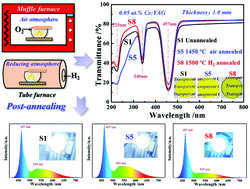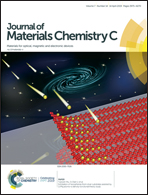Protected-annealing regulated defects to improve optical properties and luminescence performance of Ce:YAG transparent ceramics for white LEDs†
Abstract
Ce:YAG transparent ceramic, a promising photo-converter for white LED lighting, faces a significant obstacle of post-annealing treatments, which allow the simultaneous elimination of defections and the regulation of the redox state of Ce. In this paper, vacuum as-sintered high quality Ce:YAG ceramics were subjected to various annealing conditions, and their microstructural evolution, and optical and luminescence properties were monitored and studied systematically. The results showed that air annealing efficiently benefited the microstructure and optical transmittance. In addition, the absorption band below 300 nm was strongly dependent on the annealing strategies due to the elimination of defects (e.g. F/F+-type color centers) and charge transfer (CT) between Ce(III) and Ce(IV). By constructing with 1350 °C air annealed Ce:YAG ceramics, a high-performance white LED with a luminous efficiency radiation (LER) exceeding 220 lm W−1 was achieved, thanks to the “protected”-annealing condition, which guaranteed moderate CT from Ce(IV) to Ce(III) due to weakened pump light absorption by defects. Differing from traditional Ce:YAG phosphors, excrescent oxygen vacancies were introduced by annealing Ce:YAG ceramics in hydrogen, leading to deteriorated luminescence properties. Therefore, it is expected that this refined preparation of Ce:YAG photo-convertors could drive the development of white LED lighting.

- This article is part of the themed collection: Materials and Nano Research in Atlanta


 Please wait while we load your content...
Please wait while we load your content...